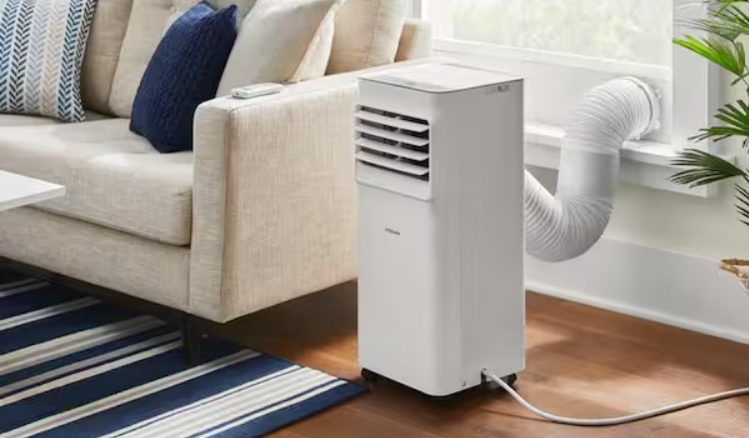
Looking to find a small but strong cooling system in small areas? A portable air conditioner of 8,000 BTU is capable of cooling bedrooms, home offices or studio apartments without being energy hogs.
Even the modern models are stuffed with intelligent connectivity to easily control and use voice commands.
Here is a speedy rundown of the best-rated 8,000 BTU portable air conditioners, each of which is made with energy efficiency, low noise, and convenient features, such as dehumidifiers and Wi-Fi/app control in mind.
| Portable AC Unit | Notable Features |
|---|---|
| Hisense 8,000 BTU Dual Hose Inverter (Wi-Fi) | Dual-hose design for faster cooling (up to 350 sq.ft.); Inverter compressor for superior energy efficiency; ultra-quiet (~42 dB on low); Wi-Fi & Alexa/Google app control. |
| Dreo 8,000 BTU Portable AC (Smart Wi-Fi) | Drainage-free self-evaporation (no bucket needed); very quiet operation (~45 dB) for small rooms (~150 sq.ft.); Wi-Fi app + voice control (Alexa/Google); “IceCool” air system reaches 14 ft. for even cooling. |
| BLACK+DECKER 8,000 BTU Portable AC (Wi-Fi) | Highly portable (lightweight, rolling casters); includes “Follow Me” remote thermostat for even cooling; Wi-Fi enabled (B+D app) with Alexa/Google voice commands; 3-in-1 cooling, fan, dehumidifier modes. |
| LG 8,000 BTU Smart Portable AC (ThinQ) | ThinQ smartphone app + Alexa/Hey Google voice control; efficient cooling for up to ~350 sq.ft.; 24-hour timer and 2 fan speeds; reputable LG build with easy digital controls. |
| SereneLife 8,000 BTU Portable AC (Wi-Fi) | Budget-friendly compact design; versatile 3-in-1 (AC, fan, dehumidifier) for rooms ~300 sq.ft.; optional Wi-Fi app control + standard remote; simple installation with window kit included (fits most windows). |
| Shinco 8,000 BTU Portable AC (Remote) | Very affordable cooling for ~200 sq.ft.; 3-in-1 function (cool, fan, dry) for year-round use; LED display and full-function remote control; compact size and quiet operation suitable for bedrooms. |
| Honeywell 8,000 BTU Portable AC (Remote) | Quiet dual-motor tech (about 50–53 dB max); Dual washable filters trap dust & dander for cleaner air; stress-free auto-evaporation (rarely empty water); trusted Honeywell durability and efficient dehumidification. |
1. Hisense 8,000 BTU Dual Hose Inverter Portable AC (Smart Wi-Fi)
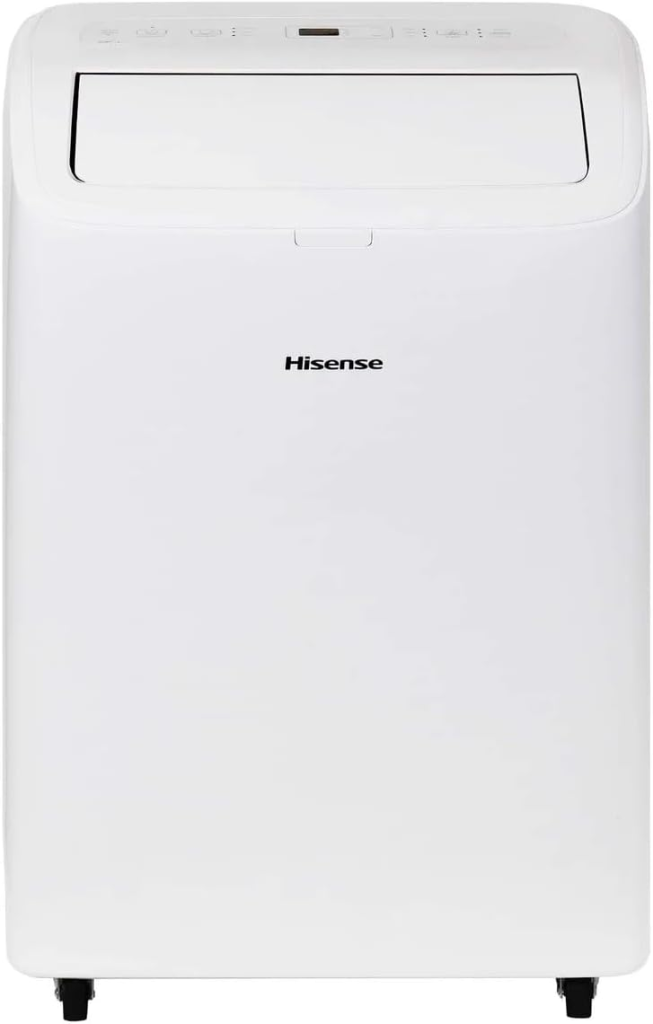
Hisense 8,000 BTU Dual Hose Inverter portable air conditioner is unique due to its dual-hose energy-efficient design and smart features. The two-hose system not only draws in outside air to cool, but also blows out the hot air, removing the indoor vacuum effect of the single-hose systems to cool quicker and more efficiently.
It has a rated coverage of \~350 sq. ft. which makes it perfect to use in bedrooms or living rooms. Its inverter compressor technology regulates speed to keep the temperature constant, and saves energy and keeps noise down: this model is as low as 42 dB on quiet mode, one of the quietest in its class. Notably, the Hisense is Wi-Fi capable, which means that it can be controlled remotely using the ConnectLife smartphone app and using voice control via Alexa or Google Assistant. It is possible to turn it on/off or change settings anywhere with your phone or smart speaker. It is a complete 3-in-1 device that has cooling, fan-only, and an in-built dehumidifier mode that eliminates excess moisture. A 24-hour timer that can be programmed and a sleep mode to gradually adjust temperature during the night to save energy. The washable filter is also a favorite of the users that remind them when it is time to clean it to enhance efficiency. It has easy mobility as an advantage, it has rolling casters and easy install window kit. On the whole, this Hisense dual-hose inverter AC is an excellent cooling device that consumes less energy and is smartly convenient, which makes it one of the best options when it comes to efficiency and connectivity.
2. Dreo 8,000 BTU Portable Air Conditioner (Quiet Smart AC)
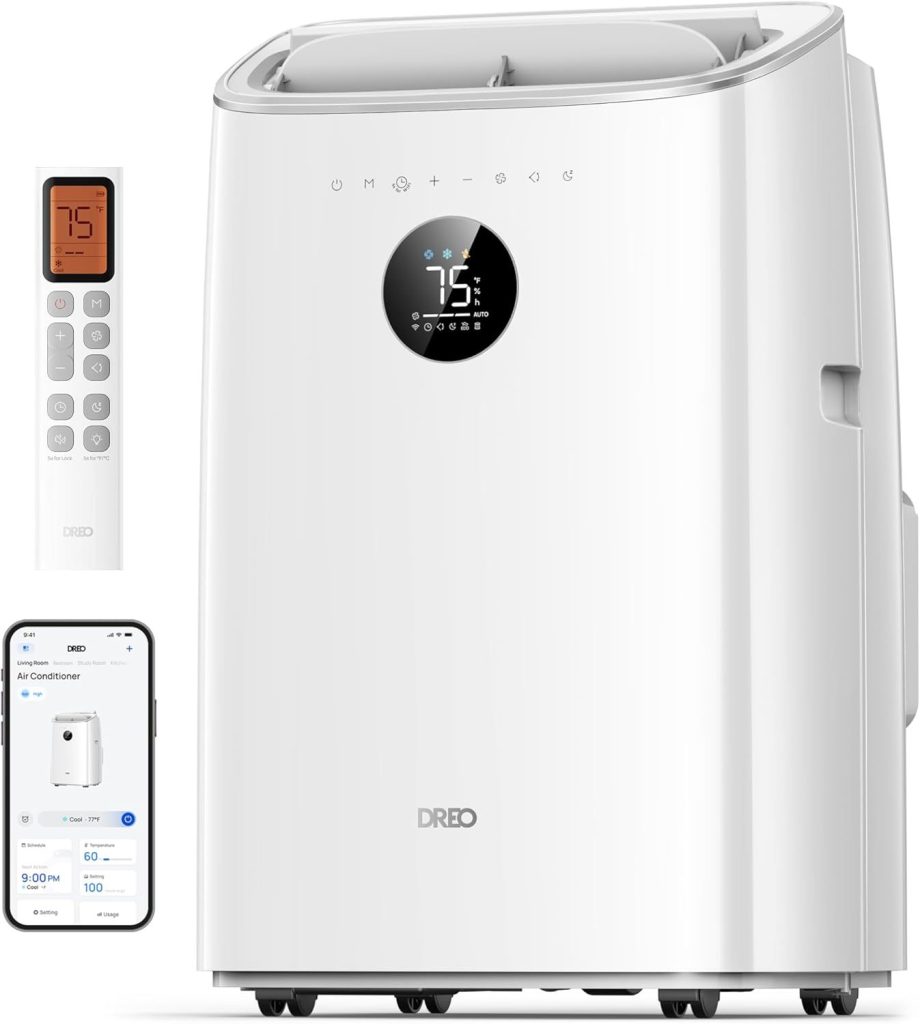
In case the priority is quiet operation and modern smart controls, the Dreo 8,000 BTU Portable Air Conditioner is a good choice. It is a smaller unit (approximately 150 250 sq. ft.) with a unique and powerful airflow system (Ultra Powerful IceCool) that can spread cold air to 14 feet away so that the cooling is even.
It is small, but powerful (8,000 BTU ASHRAE / 5,000 BTU DOE), and can be used as a fan and a dehumidifier. One of the most important features is that it is 45 dB whisper-quiet on the lowest setting, which makes it a good choice to use in bedrooms or offices where noise is a necessity. The Dreo is an intelligent Wi-Fi connected AC which can be operated by a mobile app or using voice commands. It is compatible with the most popular voice assistants (Amazon Alexa, Google Assistant, and even Siri shortcuts) to make it convenient to use without hands, you can turn the unit on/off or change temperatures by voice. You can also schedule and change modes remotely, and thus, cool the room before you get home. The other benefit is that it is self-evaporating (or drainage-free) so in normal cooling it will automatically evaporate condensate moisture out the exhaust, and therefore does not require emptying of any drip pan. This contributes to its ease of cleaning, as well as a filter that is washable. The Dreo has a 24-hour timer and a dimmable LED display, too. To conclude, this AC provides silent, effective cooling, and is accompanied by the ease of smart app and voice control, which is why it is a perfect option to use in small rooms and at night.
3. BLACK+DECKER 8,000 BTU Portable Air Conditioner (Wi-Fi Enabled)

The BLACK+DECKER 8,000 BTU Portable Air Conditioner is a combination of the reliable work of a famous brand and new smart connectivity capabilities. It is also a very portable unit, weighing about \~52 lbs, it has built in caster wheels and side handles to allow easy rolling between rooms. It is easy to set up and occupies a small area that can fit in most places.
Having a cooling capacity of \~8,000 BTU (DOE), it is enough to cool down smaller rooms (approximately 150300 sq. ft.), and keep bedrooms or small living rooms cool. This model was the best in tests as it was described as being light and power efficient, it cooled well considering its size but consumed relatively less energy. A new Wi-Fi feature is one of the most important Black+Decker advantages. The AC can be controlled remotely (turned on/off, set the thermostat, change modes) using the Black+Decker smartphone app, you can do it anywhere, which is great when you want to cool your room before you get home. It also has voice control through Amazon Alexa or Google Assistant, so you can change settings by using basic voice commands. Besides the smart controls, it also has a full-featured remote control with a Follow Me capability: the remote can be used as a thermostat sensor, instructing the AC to keep cooling until the surrounding of the remote is at the desired temperature. This assists in the realization of a more balanced cooling of the room. The unit has 3 modes, namely cooling, fan-only and a dehumidifier mode that can extract moisture (helpful in humid environments). It is also equipped with a 24-hour programmable timer and a sleep mode to cool slowly during the night. The noise level is similar to a medium fan (about Fifty-plus decibels) which is normal in portables. Overall, this BLACK+DECKER AC is a good cooling system, easy to move, and smart app/voice-controlled, with a well-established brand that is durable.
4. LG 8,000 BTU Smart Portable Air Conditioner (ThinQ & Voice Control)

The reputation of LG in the cooling technology is transferred into the portable sector with the LG 8,000 BTU Smart Portable Air Conditioner. This product belongs to the ThinQ smart appliance family of LG, which implies that it has an in-built Wi-Fi and is fully controlled via the LG ThinQ mobile app. You can control cooling start/stop, temperature, mode/fan speed and even energy consumption via your smartphone.
It is also compatible with voice assistants, and you can issue commands via Amazon Alexa or Google Home to switch the AC on/off or adjust the thermostat, which is a real hands-free experience. This is a good option of the LG when one wishes to integrate his or her AC to a smart home system. As far as cooling capacity is concerned, the LG provides powerful cooling to rooms of 300-350 sq. ft. (including a 14 x 25 room) due to its 8,000 BTU DOE rating. It provides several operating modes: cool, fan-only and a dry mode that serves as a dehumidifier (assisting in eliminating excessive humidity on sticky days). The two speeds of the fan and a 24-hour programmable timer enable you to set the time the AC should switch on or off. According to users, this model is comfortable even in the medium-sized rooms and can lower the temperature rapidly. It is as noisy as other units of this size- loud enough to wake most people up (on low fan setting, the noise is similar to background white noise). The device is a digital display, modern, and it also has a remote control, in case you are not using the app. It also has an easy-install window vent kit and caster wheels just like others. It is well built, with a smooth design by LG and a white finish. All in all, LG 8,000 BTU Smart Portable AC is a trustworthy cooling unit with smart app/voice control and the comfort of a well-known brand in home appliances.
5. SereneLife 8,000 BTU Portable Air Conditioner (Affordable Smart Cooling)
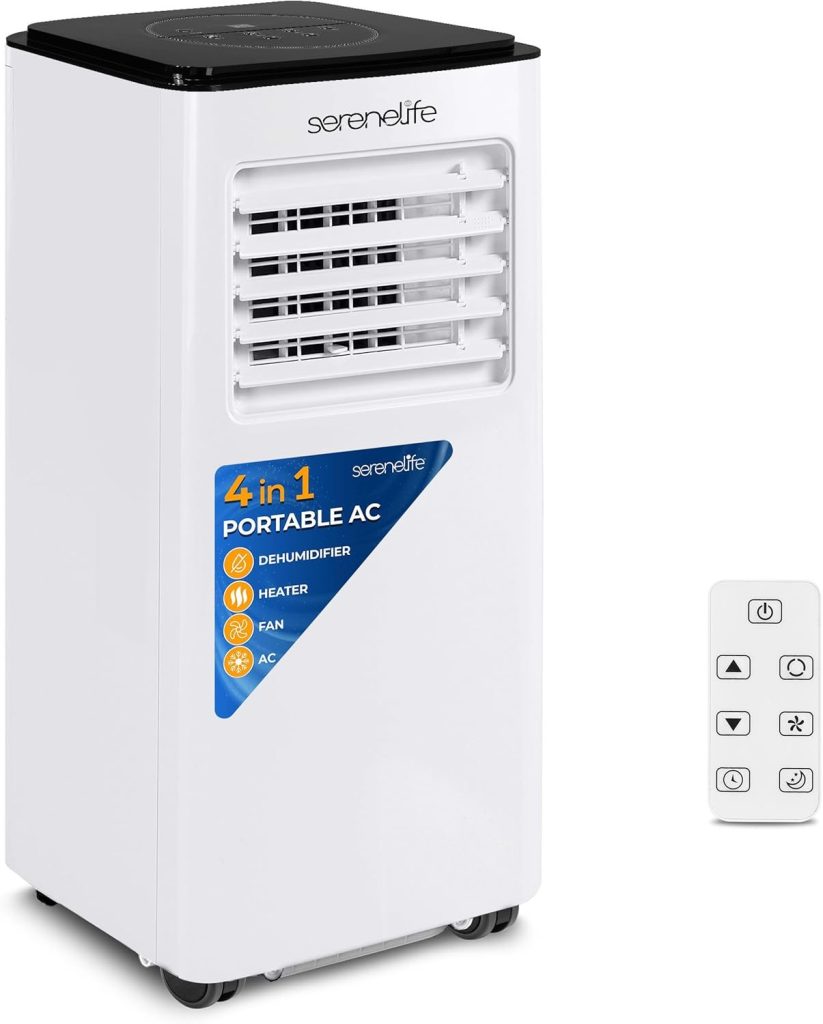
The SereneLife 8,000 BTU Portable Air Conditioner is a good choice when it comes to budget shoppers since it offers decent cooling power and even has smart capabilities, such as Wi-Fi. The unit has become a hit among people who are looking for a cheap 3-in-1 cooling system, it is an air conditioner, a regular fan and a dehumidifier (dry mode) in one small device.
It has 8,000 BTU (ASHRAE) of cooling capacity (approximately 5,000 BTU DOE), which is appropriate in rooms of 200300 sq. ft., including a bedroom, dorm, or a small apartment living room. The form factor is fairly thin and space-saving, being approximately 2 feet in height, and thus it can easily fit into a corner. It also includes a full window exhaust kit and instructions and people have remarked that it is easy to install even to a first-time user of portable ACs. The SereneLife does not compromise on convenience even though it is cheaper. It is worth mentioning that this model provides Wi-Fi app control (as well as a physical remote). When you have connected it, you can manage power, mode, and temperature using your phone or tablet. It is convenient to use when you want to switch the AC on when you are not in the room or to change the settings without aiming at the remote. (It is worth mentioning that not all buyers were satisfied with the Wi-Fi installation process, which requires adherence to the manual to the letter, so be sure to connect to the 2.4GHz Wi-Fi band, as is typical of smart appliances.) Moreover, it also has a digital touch button control panel on the top to be operated directly. It is also fast at cooling a small room, and can even remove a reasonable amount of moisture in the air when set as a dehumidifier (to make a room less clammy). The noise of the SereneLife is about the middle of the 50s decibels at high fan, which is not the lowest, but comparable to most inexpensive portable ACs (most owners use the low fan setting at night to make it quieter). It has important features such as 24-hour timer, sleep mode and automatic restart in the event of power failure. The SereneLife 8,000 BTU model is frequently suggested as a budget choice by those who require efficient cooling but do not want to spend a lot of money on it due to its competitive price and set of features, such as caster wheels, a removable washable filter, and the possibility of smart Wi-Fi control.
6. Shinco 8,000 BTU Portable Air Conditioner (Budget Pick with Remote)
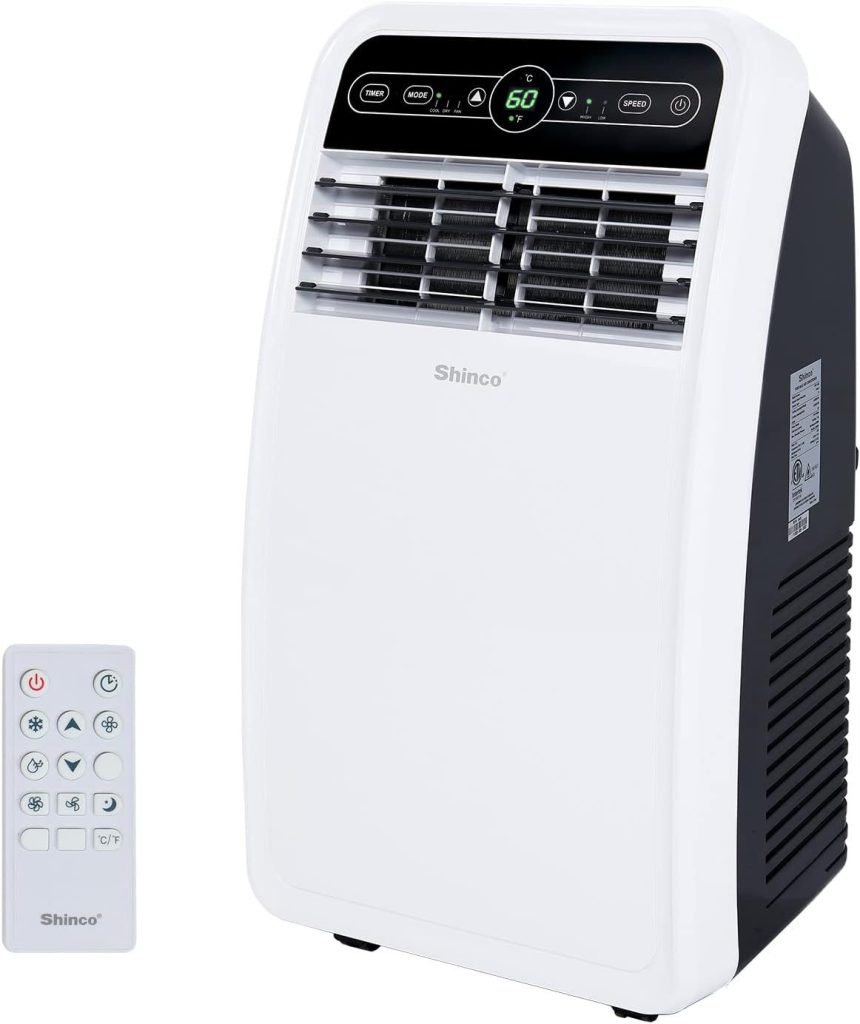
The Shinco 8,000 BTU Portable Air Conditioner is a low-frills, budget choice that you can use to cool down. The unit is simple and affordable, and it has the essential features you require to cool a small room without any additional features. It has a 3-in-1 feature, i.e., you can either use it in cooling mode, fan-only mode, or a dehumidifier (dry mode).
It has about 8,000 BTU (ASHRAE) cooling capacity (about 5,500 BTU DOE) and can cover an area of about 200 sq. ft. like a bedroom, small den or office. It will not cool big spaces but in a well-sized room, it will reduce the temperature by a few degrees and make the room comfortable during summer. The Shinco has a user-friendly electronic control panel and a full-function IR remote control which allows you to control the settings of the TV even when you are in another corner of the room. You may select the temperature you want, use 2 fan speeds, and use a timer (up to 24 hours) to automatically switch the unit on or off. The easy to use LED display and controls are liked by many, as it is really plug-and-play. It is also easy to install: it comes with a window venting kit that can be fitted in most standard windows (you may have to cut the slider to the height of your window, as is the case with most windows). After the installation, this AC will begin to cool within no time; Shinco sells the unit as being able to cool down small rooms within a very short time and the customer review in most cases concurs that it is a smart buy when it comes to cooling small rooms fast. Noise-wise, you should get a soft hum, about in the Fifty-something decibel range on high fan, which is audible but commonly referred to as the level of background noise (most budget portables are the same). A small size of this unit is one of its advantages since it is relatively lightweight (less than 50 lbs) and has caster wheels, which makes it easy to transport or store during the off-seasons. It requires little maintenance: it has a washable filter which you should rinse every few weeks, and as most portables it will auto-evaporate condensate in moderate humidity. (In extremely moist weather you may have to drain off water occasionally through a bottom plug.) It is not a high-tech smart AC, and it does not operate at an ultra-low noise level, but the Shinco 8,000 BTU AC does the basics well: it is cheap, it is dependable, and it comes with a remote control, so it is a good option when you have a tight budget or need a backup air conditioner that you can use on demand.
7. Honeywell 8,000 BTU Compact Portable Air Conditioner (Quiet & Efficient)
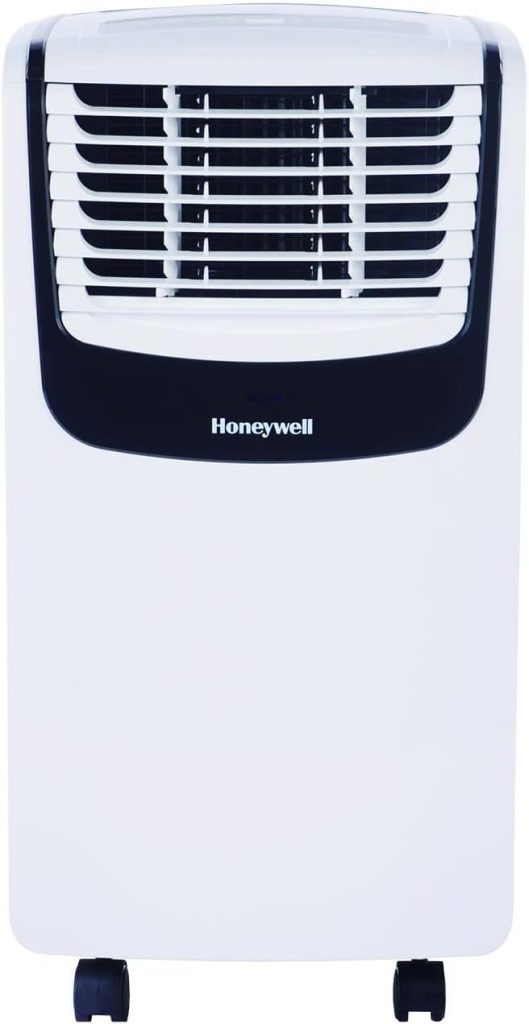
The portable AC units of Honeywell are famous in terms of their build quality and efficiency and the same can be said about the Honeywell 8,000 BTU Compact Portable Air Conditioner (model MO08CESWK6). This unit is 9,100 BTU (ASHRAE) / 6,100 BTU (SACC DOE), which is appropriate to cool smaller to medium size rooms up to approximately 300 sq. ft.
It is superior in the aspects in which some portables are weak, especially in noise and filtration. Due to the dual-motor technology, it is also much quieter than most of the competitors, even at the highest fan speed, it makes about 50 to 53 decibels, which is noticeable but not excessive (a bit like a quiet conversation). The fact that it is quiet in its operation is a specific feature that many users select this model because it is suitable in bedrooms or nurseries. The other strength is that the unit is energy efficient and has an air filtration system. It has a washable dual filtration system which captures dust, pet dander and hair before they reach the AC and this prevents air impurities and damages to the internal components. This does not only make the air quality of your room a bit better but also prolongs the life of the AC, since the evaporator coils are cleaner. It is very easy to maintain as the filters can be washed under a tap every now and then. Auto-evaporation in cooling mode is also used in the Honeywell, so in normal operation you will not have to empty a condensate tank, the water is evaporated through the exhaust hose. (The backup tank can fill up with time in very humid conditions, though in most cases, it is really hassle-free.) Being a 3-in-1 device, it provides cooling, multi-speed fan, and dehumidifier with the ability to remove up to 44 pints per day to make your space dry. It also has a well-defined digital control panel and a complete remote control. The window kit that comes along is of good quality and fits both vertical and horizontal windows. It lacks Wi-Fi, but this is not the point here, it is all about performance and reliability and in fact it is ENERGY STAR-rated in some jurisdictions to meet efficiency requirements. On the whole, Honeywell 8,000 BTU portable AC is a balanced product with the focus on silent, effective cooling and convenience. It is supported by a well-known brand and would suit you well in case you appreciate a long lifespan, low noise and low maintenance of a portable air conditioner.
Buying Guide: How to Choose the Best 8,000 BTU Portable Air Conditioner
The process of choosing the appropriate portable air conditioner depends on the conditions of your particular room and the features that are of the most importance in terms of comfort and efficiency.
This is how to compare when buying the best 8000 BTU portable air conditioner:
Room Size and BTU Capacity
Differentiate the AC BTU with the size of your room. A 8,000 BTU (DOE) portable air conditioner is typically appropriate in small to medium-sized rooms 150 to 300 sq. ft. (depending on the height of the ceilings, the insulation, etc.). The old ASHRAE standard was used by manufacturers to advertise a higher BTU (e.g. 12,000 BTU which really means about 8,000 BTU DOE).
When the DOE/SACC rating is available, use it since it is a measure of performance in the real world. Depending on the size of your room on the higher side (\~300 sq.ft with a high exposure to sun) 8k BTU might not work well on the very hot days, so take your climate into account. Undersizing is not a good idea, a unit that runs continuously will not be as efficient at dehumidifying and cooling. Conversely, do not make the unit too large; an overly-strong unit can short-cycle and fail to dehumidify adequately, resulting in a clammy sensation. Eight thousand BTU is a good compromise between cooling and energy consumption in most bedrooms, home offices or dorms. According to one of the reviews, an 8k unit is only good enough in small rooms but will not cool a big living area. Measure your room and see the recommended coverage area of the AC to fit well.
Energy Efficiency (EER, Inverter and Dual-Hose)
Portable ACs are reported to use a reasonable amount of energy but it has features that enhance their energy efficiency. Find a better EER (Energy Efficiency Ratio) or CEER (Combined Energy Efficiency Ratio) – this is the BTU output divided by power consumption (W). EER of 8 or more is typical of this class. More sophisticated models have inverter compressors, which are able to vary speed rather than just turn on and off.
Inverter models, such as the Hisense one above, are more likely to consume less power and maintain temperatures constant (and they are usually quieter because the compressor does not switch on and off all the time). They are basically variable speed ACs and can save a lot of energy and have improved part-load performance. The other is the ventilation design: dual-hose and single-hose. Dual-hose portables contain one inlet and one exhaust pipe. This design avoids the AC drawing in warm air through cracks around doors or windows (a disadvantage of single-hose units which generate a small negative pressure). By getting rid of that problem, dual-hose ACs cool the rooms more efficiently and quicker. They are likely to cover more areas or greater heat loads with the same BTU rating. When the energy efficiency is a primary consideration and you do not mind having a second hose, a dual-hose system is the suggested one. It should be noted that dual-hose models can be slightly more complicated to install (two hoses in the window slider rather than one) but the reward is better performance and in many cases reduced running costs. To conclude, to be as efficient as possible, choose a model that has inverter technology or dual-hose design (preferably both) and see whether it has an Energy Star certification. These characteristics will make sure that you will receive the best cooling per watt and save electricity during the season.
Noise Level (dB Rating)
Since portable ACs are placed in your room, noise level is a factor that should be considered particularly when you want to use it in a bedroom or during work. The manufacturers will occasionally give a decibel (dB) rating. In the case of 8,000 BTU models, the average noise is about 50 dB at low fan speed and \~55 57 dB at high.
To put it into perspective 50-53 dB is roughly the noise of a normal conversation or a moderate rain. In case you are a light sleeper or will be in a close vicinity of the unit, seek models that are specifically mentioned as being low-noise or having a dB rating in the low 50s or 40s. As an example, Honeywell dual-motor technology maintains the noise level of their units at around 51 54 dB even when they are running at high speed and the Dreo unit reviewed above runs at a very low 45 dB on the quiet mode, which is extremely low for a portable AC. Remember that perception of noise may be subjective, it depends on the kind of sound. Inverter units are also more likely to be more consistently humming (without the jolting compressor on/off kicks), which many people find more easily to tune out. The Sleep mode in some ACs slows down the fan and dims the lights to ensure that the unit is not loud at night. Read user reviews on noise, if you can; an AC may have a low dB rating, but may emit some frequencies of noise that people find irritating (e.g. a high-pitched compressor whine, as opposed to a lower-pitched hum). As a rule, smaller BTU units run quieter than the larger ones, and this is an advantage of the 8,000 BTU unit size, they tend to be quieter than the 12k+ BTU portable units. It can also be set on a flat surface and the filters and internal parts cleaned so that the unit runs as silently as possible. In case ultra-quiet cooling is a must, you may want to look at a two-hose inverter, or even a window AC (some U-shaped window units run as low as 42 dB) – but among portables, there are some good quiet models. Intend to use the sleep mode or low fan setting when the noise has to be reduced.
Smart Features and Controls
The new generation of portable ACs is getting smarter and smarter, with additional features that make them more convenient and allow controlling the climate more accurately. The Wi-Fi enabled units will give you the ability to control the AC using a smartphone app wherever you are. This implies that you are able to switch the AC on before you arrive at home, set the settings without leaving the bed, or track and program the operation when you are on the move.
Such brands as LG, Hisense, and Black+Decker provide apps that connect their ACs to your home Wi-Fi. And in case you do not want to use an app, make sure the unit at least has a full-function remote control (most do), so you can change temperature and modes across the room. Other remotes, such as the so-called Follow Me remote of Black+Decker, are also thermostat sensors, which can be useful in ensuring more uniform cooling of the area, by avoiding premature shutdown of the unit before the distant end of the room is cool. Another common feature is voice control, and the units that are compatible with Amazon Alexa or Google Assistant allow you to control them with voice commands, such as, Alexa, turn on the air conditioner to 72 degrees. This may be fabulous in terms of accessibility or just because you are a tech-lover and would like to incorporate the AC into your routine (you can add the AC to a bedtime routine through Alexa, and it will automatically turn on). In the case of smart features, you should also take into account the reliability of the app/software and whether it offers such features as scheduling or programmable thermostats. Other clever AC apps permit fine-grained scheduling (such as several on/off events per day or various settings by day of week), but a non-smart model may just have a basic 24h timer. When you have other smart home devices, make sure they are compatible, e.g. LG ThinQ app can group an AC with other LG appliances and some ACs may be compatible with SmartThings or IFTTT to enable advanced home automation. But, in case you like simple things or are afraid of privacy, a conventional unit without Wi-Fi may be just great, you will still have cooling as long as you can adjust the temperature and the fan speed to your needs. In such case, concentrate on the core performance and think of smart functionality as an added feature but not a need.
Dehumidifier (Dry) Mode and Drainage
Every portable AC is more or less a dehumidifier as it cools (they condense moisture out of the air).
A standalone Dry mode, that operates the compressor and fan at low speed to draw moisture without aggressively cooling, is also present in many units. This comes in handy during rainy or humid seasons when you only wish to dry up the air. In case you reside in an extremely humid climate, you should be careful about how the unit handles condensate (water).
Auto-evaporation is a characteristic that most or all of the condensed water is evaporated and sent out the exhaust hose as vapor. This implies that you do not have to empty a tank frequently. The cooling mode in most better units, all of which are listed in our review, is auto-evaporation.
As an illustration, one user mentioned the fact that he/she never had to worry about water drainage in his/her portable AC, and it was a major plus. But at Dry mode or high humidity, auto-evaporation may not be able to keep up and the surplus water is stored in a reservoir inside. When this happens the unit will usually switch off and tell you it is full and you can empty it through a plug at the bottom. In case you intend to use dehumidify mode regularly, you may consider connecting a hose to drain the water continuously (most models are available with a drain hose option).
Compare the models, and look at the dehumidification rate – some 8,000 BTU models can dehumidify approximately 2 to 2.5 pints per hour (approximately 48 to 60 pints per day) when operating in Dry mode. This compares to a medium sized dedicated dehumidifier. This can be a great comfort feature in case your locality becomes clammy. Also, the convenience of reaching the drain port and the accessories that are included (is there a short drain hose, etc.). When in cooling mode, and you notice that your unit is constantly producing water, make sure that the filters are clean (in case of poor airflow, it may decrease the effectiveness of evaporation) and that the room is not extremely humid. Otherwise, seek one that is specifically commended in the way it deals with humidity.
Size, Portability and Installation
Portable ACs have one of their selling points as they are relatively easy to install and move as required. Nevertheless, one should verify the dimension and weight of a unit to be aware of what one is getting.
The average weight of 8,000 BTU portables is 45 to 60 lbs and their height is 24-30 inches. The lighter the better in case you will have to carry it up and down the floors or in and out of storage.
All the units are fitted with casters (wheels) and some kind of handle or grip, which makes it easy to roll them on smooth surfaces. Portables are excellent to use when you are a renter or cannot fit a window AC, all that is needed is a proper window or sliding door to blow out the hot air.
Installation: The window slider kit is fitted and the exhaust (and intake, in the case of dual-hose) hose is attached. Most window widths will fit in kits, but when you have very wide windows or a sliding glass door you might need to buy extension panels or an extra-long kit. Make sure that the kit supports the min/max window width. As an example, the kit made by LG will suit the windows with the width of 25-47 inches. Installation is usually a one man task: you open the window, slide the slider in, pull it out to fit and close the window to clamp it. Weather stripping or foam is normally supplied to seal openings. The exhaust hose will then be snapped or screwed onto the adapter which is inserted in the window panel.
Flexibility: you should take into consideration that the unit should be fairly near the window (most of them have hoses of 4 to 5 feet). You will also want to put it somewhere that it is not too obtrusive, a corner of the room is good, so long as the hose can run fairly straight (avoid sharp bends in the hose, which reduce efficiency). In case you want to move the AC between rooms, consider models with an easy window kit removal: some kits can be removed in and out of the window without unscrewing everything, which is convenient when you use the AC in your living room during the day and bedroom at night. Remember that to relocate the unit, you will have to relocate the venting system too, so practically the majority of people leave it installed in a single room.
Lastly, there is storage: when you use the AC only during summer, you will have to store it during the winter. Units that are smaller in size or those which are provided with a storage cover may gain an advantage here. Empty any water, clean the filter and store it, and remember to keep the hose and window panels together, so you do not lose any parts.
Maintenance and Other Features
In order to maintain your portable AC in good working condition, regular maintenance is easy but necessary. The first thing is the cleaning of the air filter.
The majority of portables possess a slide-out filter (or a set of filters) that ought to be rinsed or vacuumed approximately every two weeks in the event of intensive use. The airflow will be restricted by a clogged filter and may lead to overheating or poor cooling. Most models such as the Hisense and Honeywell have filter clean reminder indicators to remind you when it is time to clean the filter, a useful feature when you are likely to forget.
In addition to this, check every now and then the hoses to see whether they have any cracks or leaks, particularly when the unit has been stored and make sure that the connections are tight so that the warm air does not leak back in. The other maintenance advice is the control of the condensate water. With auto-evaporation, you may have to drain the unit, especially when you live in a humid place. This is normally through a tiny plug at the bottom of the unit. Have a shallow pan or dish ready, or have a small hose attached, in case furnished. In moderate conditions, 8,000 BTU units normally require draining only occasionally, or not at all. In the event of running in Dehumidify mode all the time, install a continuous drain where possible.
Seek additional ease of use features: remote control storage (there is a place to dock the remote on the side of some units), cord management (a wrap or clip to store the power cord when not in use), and auto-restart feature (this means that when power goes out, the AC will restart with previous settings when the power returns, which is essential when you leave it unattended or use a smart plug).
A louver or an oscillating front vent can be adjusted to blow air more evenly throughout your room. As an example, LG and Whynter models have auto-swing louvers. It has standard manually adjustable louvers that enable you to tilt the air either up or down.
Finally, there is the look and body. Such devices will take up space in your room, and you may want a more streamlined design or a particular color (most are white or gray). All the models suggested here are rather modern and neutral in color. Honeywell has black/white versions, LG usually has glossy white with grey accents, etc. The build quality can be different, more expensive models can be made of more durable plastics and perform more smoothly, very cheap models can be flimsier. Since a decent portable AC can serve you many summers provided that you take care of it, it will be worth spending money on a quality one that is simple to maintain.
Considering such aspects as cooling power, efficiency, noise, smart tech, and maintenance, you will be able to choose the 8000 BTU portable air conditioner that will best suit your needs. The above-reviewed models have their strengths and weaknesses, and each of them is better in one way or another, so it is worth considering what features are more important to you. When you make the right decision, you will have a cool and comfortable area and easy control as well as energy consumption under control.


